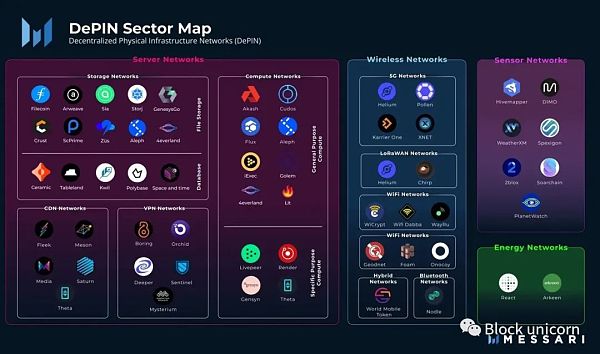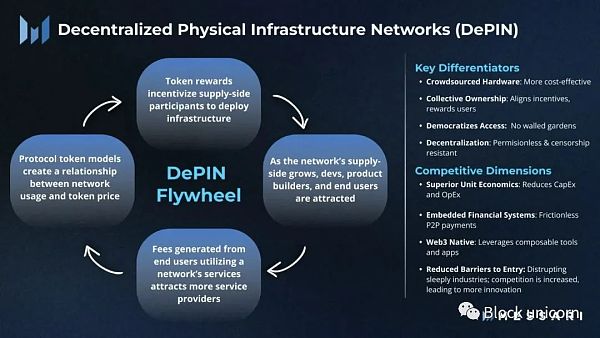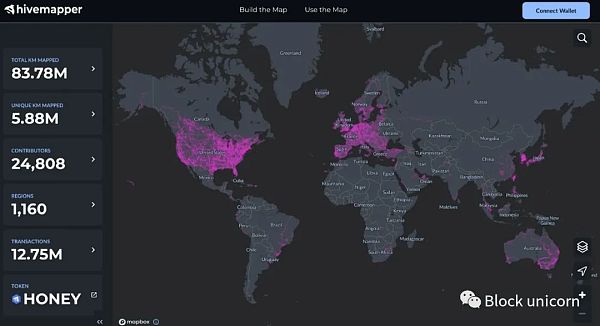DePIN:去中心化物理基础设施网络
引言
DePIN(Decentralized Physical Infrastructure Networks)是过去一年中不断上升的趋势之一。DePIN的核心承诺是将区块链应用的原则(作为社区拥有、公开可验证和激励对齐)带入到物理 “ 事物 ” 和基础设施的世界,无论是WiFi站点、安全摄像头还是计算服务器。在本文中,我们将探讨DePIN的一些核心原则,然后探讨一些最具代表性的DePIN项目,最后讨论DePIN对区块链领域的更广泛影响。
概念化DePIN
DePIN涵盖了各种各样的项目。从像Arweave和Filecoin这样的去中心化存储网络,到像Helium这样的去中心化WiFi连接,再到像Hivemapper这样的社区源软件应用,所有这些都被定义为“DePIN”。Messari在其2023年1月的开创性DePIN报告中做出了这一观察,将DePIN分为四个主要领域:去中心化服务器、无线、传感器、能源网络。

从Messari所界定的项目和领域中,我们可以看到DePIN的最初定义在很大程度上偏向于项目的“物理”性质——利用传感器、服务器和路由器在硬件层面上创建一个从底层到上层的去中心化互联网堆栈。然而,自那时以来,DePIN的这一普遍概念逐渐扩展,包括了更多面向消费者的应用,比如旨在构建“去中心化Uber”的TRIP。因此,这带来了一个问题:我们如何开始概念化“DePIN”指的是什么?
因此,我们的第一个任务是注意这一广泛项目范围中的概念相似性,无论是在最初的Messari报告中还是在这个术语逐渐演变的过程中。这些项目中的许多都共享一些相似之处,包括集体所有权、去中心化的基础设施成本、随着更多用户进入生态系统而逐渐扩大的规模经济 。事实上,这可以总结为Messari的DePIN飞轮,解释了通过代币激励如何促成这一点。

上面的DePIN飞轮最初只被构想为涵盖“物理基础设施”网络,比如Filecoin和Helium,用户为网络提供资源(磁盘空间或WiFi连接),作为回报获得代币奖励,从而允许网络拥有更多容量并吸引更多用户 。
然而,这个飞轮不仅局限于硬件基础设施;对于数据基础设施也有类似的论点。这将包括那些以收集和协调消费者数据为中心的项目,使用区块链和代币作为协调新数据经济的公共接口。这可能包括面向消费者的应用,如Messari所指出的“传感器网络项目”和类似“去中心化Uber”的项目,以及区块链在供应链或物流管理中潜在的企业应用(尽管在这里,对代币的金融化关注会少得多)。
因此,概念化DePIN趋势的一种可能方式是将去中心化硬件层与社区拥有的新数据经济相融合。
DePIN案例研究
在对DePIN进行了一般性描述之后,我们现在可以探索该领域内一些最具特色的项目。
Helium(HNT)
Helium是最古老、最显赫的DePIN项目之一,于2013年成立,旨在通过让用户以去中心化的方式部署LoRa网关来扩展宽带基础设施。2017年,该网络决定抓住加密货币的势头,并开始通过其自己的L1区块链网络提供加密货币支付。
Block unicorn:LoRa技术可以支持设备之间的无线通信,使其能够在较长的距离范围内传输小量数据,这对于物联网设备的连接是非常有价值的。在Helium项目中,LoRa技术用于用户部署LoRa网关,从而扩展宽带基础设施。
多年来,这一方法使Helium不仅成为DePIN的代表性项目,而且更广泛地成为加密行业的代表。许多人将其称为“人民网络”,因为它是一个重要的项目,人们可以清晰地看到如何使用代币来激励社会有益的行为。然而,随着时间的推移,Helium网络和协议都遇到了流动性和采用问题,网络的周收入一直在稳步下降。批评者还指出,网络的用例被夸大了,激励是不可持续的。

截取自 Coinmarketcap 的数据,时间范围为 2022 年 2 月至 2023 年 3 月,获取日期为 2023 年 11 月。
在 2023 年 4 月,Helium 完成了从其独立的 L1 区块链过渡为 Solana 上的应用 ,这一举措旨在提升用户的覆盖率和流动性,并利用 Solana 的高交易吞吐量进行扩展 。
Helium 的这一例子突显了 DePIN 领域内的一些关键机遇和风险。代币在启动真实世界用例的行为方面可能非常有效,但在较长时期内维持足够的合理性和兴趣水平却相当困难。此外,随着 L1 和 L2 逐渐整合,更难以提出一个独立运行链的论点,而不是利用其他更广泛采用的链提供的可扩展性、基础设施和流动性。
Hivemapper
Hivemapper 是 Solana 网络上另一个重要的 DePIN 项目,旨在创建一个去中心化的“谷歌地图” 。基本上,该项目的用户在他们的汽车上安装行车记录仪,并与 Hivemapper 分享实时录像,以换取 HONEY 代币 。然后,该公司使用所有这些分布式数据构建了一个带有应用程序 API 接口的去中心化地图 。

Hivemapper 相对于谷歌地图的关键优势在于,作为一个去中心化、激励代币的网络,它能够以更便宜且更快的方式完成代币映射过程。因此,Hivemapper 能够提供更便宜的 API,作为“打破”谷歌地图垄断的一种方式 。
Hivemapper 凸显了 DePIN 的核心“飞轮”原则,即我们使用代币以一种高效的方式执行分布式、去中心化的任务。有趣的是,在最初的 Messari 报告(2023 年 1 月)中,Messari 将 Hivemapper 描述为“传感器网络”的典型例子 。然而,有人可能认为这并没有充分捕捉到 Hivemapper 的真正创新。
事实上,Hivemapper 的核心竞争力在于它所收集的数据基础设施——来自用户网络的去中心化数据——然后通过提供 API 访问来货币化该数据基础设施。
当然,该项目使用传感器和行车记录仪来收集这些数据;但这只是一种偶然情况。我们可以想象,即使这些数据不是由“传感器网络”生成的,而是通过其他活动生成的,比如浏览(比如 Brave 浏览器)甚至是用户与人工智能交互生成的,同样的整体模型可能仍然成立。DePIN 利用代币激励通过去中心化的方式生成大规模数据(比如通过去中心化的硬件网络),从而创造出新的数据经济。
Teleport
Teleport 是 Solana 上的一个去中心化 Uber 竞争对手 ,其重要性更加明显,因为它是 Solana 的 “Breakpoint” 大会上的一个关键参与者,最近还推出了应用程序(2023 年 10 月)。Teleport 是 “The Rideshare Protocol”(TRIP)的重要组成部分,该协议旨在创建一个公平而独立的市场,无需中介或中心化前端获取骑行收入的重要部分(通常高达 40% 以上)。
尽管 Teleport 和 TRIP 的采用和持久性仍有待观察,但 Teleport 是一个重要的案例研究,展示了开放和去中心化的 “数据市场” 作为 DePIN 项目的核心价值主张的重要性。
IoTeX
IoTeX 是 DePIN 领域的另一家关键参与者,突显了区块链技术与去中心化硬件设备如何在社会层面带来不同维度的好处,即安全性和隐私维度。IoTeX 的旗舰产品是 Ucam,这是一款只有用户自己可以访问的家用安全摄像头,其数据通过区块链的加密和不可变属性进行保护 。
随着 DePIN 总体趋势在过去一年内的增长,IoTeX 的目标是不仅构建特定的智能设备,还要构建一个物联网设备的 “开放网络” 并推广 “MachineFi” 概念 。然而,正如 Helium 的故事所显示的,在整体上整合的 L1 场景的背景下,即使 DePIN 为区块链提供了强大的消费者用例和应用层,要为一个独立而专业化的网络提供论据并在这样的生态系统中引导流动性也变得越来越困难。
更广泛的生态系统影响
在过去一年中,DePIN 的增长对整体区块链生态系统产生了相当大的影响和深远意义。其中最重要的原因之一是,DePIN 是一个面向消费者的应用层,类似于 DeFi、游戏和社交,具有大规模采用的潜力,可以推动对底层链或生态系统的消费者需求。
正如上面的例子所示,Solana 似乎是 DePIN 领域活动非常活跃的链,还有其他一些参与者,如 IoTeX,致力于构建为 DePIN 定制的新颖替代解决方案。作为与大量用户和物联网设备互动的应用层,可能会对高性能和可组合链产生需求 - 那些能够承载大规模消费者的负载需求,并且通用语言如 Rust 和 WebAssembly 可以轻松在物联网设备上运行。
此外,DePIN 趋势的增长还对去中心化治理产生了下游影响。在推出代币后,习惯上会启动一个由基于代币的投票协调的去中心化自治组织(DAO),许多杰出的 DePIN 项目似乎在其路线图上设有 DAO 治理 。
目前大多数显著的 DAO,如 Uniswap、Compound 和 MakerDAO,几乎都与数字或金融化资产有关。但随着 DePIN 项目的成熟并逐渐将治理交接给 DAO,将会对 DAO 协调购买、使用和维护物理设备(无论是服务器、传感器还是硬盘驱动器)的需求不断增加。因此,DePIN 可能成为一个趋势,将 DAO 的治理权限从数字资产扩展到物理资产,最终创造可能需要 DAO 运作和行为更像传统公司的任务,从而在长期内标志着“web3”在“现实世界”中的采用。
Introduction is one of the rising trends in the past year. The core commitment is to bring the principle of blockchain application into the world of physical things and infrastructure as a community with open verifiability and incentive alignment, whether it is a site security camera or a computing server. In this paper, we will discuss some core principles, then discuss some most representative projects, and finally discuss the broader impact on the blockchain field. Conceptualization covers a variety of projects from decentralized storage like and this. Network to decentralized connection like this and then to community source software application like this are all defined as the observation made in its groundbreaking report in June, which will be divided into four main areas: decentralized server, wireless sensor energy network. From the defined projects and fields, we can see that the initial definition is largely biased towards the physical properties of the project, and sensor servers and routers are used to create a decentralized interconnection from the bottom to the top on the hardware level. However, since then, this universal concept has gradually expanded to include more consumer-oriented applications, such as decentralized construction, which brings a question: how do we begin to conceptualize what it means? Therefore, our first task is to pay attention to the conceptual similarity in this wide range of projects, whether in the initial report or in the process of the gradual evolution of this term, many of these projects share some similarities, including decentralized collective ownership. The cost of infrastructure is gradually expanding as more users enter the ecosystem, which can be summarized as economies of scale. In fact, this can be summarized as the flywheel, which explains how to promote this through token incentives. At first, the flywheel above was only conceived to cover physical infrastructure networks, such as providing resources, disk space or connections with users for the network in return, so as to allow the network to have more capacity and attract more users. However, this flywheel is not limited to hardware infrastructure and data infrastructure. There are similar arguments, which will include those projects that focus on collecting and coordinating consumer data, using blockchain and tokens as a common interface to coordinate the new data economy, which may include consumer-oriented applications, such as sensor network projects and similar decentralized projects, as well as the potential enterprise applications of blockchain in supply chain or logistics management, although there will be much less attention to the financialization of tokens here, so one possible way to conceptualize the trend is to combine decentralized hardware layers with After a general description, we can now explore some of the most distinctive projects in this field, which is one of the oldest and most prominent projects. It was established in 2000 to expand broadband infrastructure by allowing users to deploy gateways in a decentralized way. In 2000, the network decided to seize the momentum of cryptocurrency and began to provide cryptocurrency payment technology through its own blockchain network, which can support wireless communication between devices and enable them to Transmitting a small amount of data in a long distance is very valuable for the connection of Internet of Things devices. In the project, technology is used for users to deploy gateways to expand broadband infrastructure. Over the years, this method has become not only a representative project, but also a representative of the encryption industry more widely. Many people call it People's Network because it is an important project. People can clearly see how to use tokens to stimulate socially beneficial behaviors. However, with the passage of time, networks and protocols have become both. Encountered the problem of liquidity and adoption, the weekly income of the network has been steadily declining. Critics also pointed out that the use cases of the network are exaggerated, and the incentives are unsustainable. The time range of the data intercepted is from year to month, and the date of acquisition is from year to month. This move aims to improve the coverage and liquidity of users and expand by using the high transaction throughput. This example highlights some key opportunities and risks in the field. The behavior of world use cases may be very effective, but it is quite difficult to maintain sufficient rationality and interest level in a long period of time. In addition, with the gradual integration, it is more difficult to put forward the argument of an independent running chain instead of using the extensible infrastructure and liquidity provided by other more widely used chains. Another important project on the network aims to create a decentralized Google map. Basically, users of this project install driving recorders in their cars and share real-time videos with them. In exchange for tokens, the company then used all these distributed data to build a decentralized map with application interface. Compared with Google Maps, the key advantage is that as a decentralized network to stimulate tokens, it can complete the token mapping process in a cheaper and faster way, so it can provide a cheaper way to break the monopoly of Google Maps, highlighting the core flywheel principle that we use tokens to implement distributed decentralization in an efficient way. The interesting thing about the task is that it will be described as a typical example of sensor networks in the initial reporting years. However, some people may think that this has not fully captured the real innovation. In fact, the core competitiveness lies in the fact that the data infrastructure it collects comes from the decentralized data of the user network and then monetizes the data infrastructure by providing access. Of course, the project uses sensors and driving recorders to collect these data, but this is only an accidental situation. We can imagine that even if these data do not. It is generated by sensor networks, but through other activities, such as browsing, or even the interaction between users and artificial intelligence. The same overall model may still be valid. Using tokens to generate large-scale data through decentralization, such as through decentralized hardware networks, to create a new data economy is a decentralized competitor in the world, and its importance is more obvious because it is a key participant in the conference. Recently, an application has been launched. The agreement aims to create a fair and independent market without intermediary or centralized front end, and an important part of the riding income is usually as high as above. Although the adoption and persistence of the agreement remain to be seen, an important case study shows the importance of an open and decentralized data market as the core value proposition of the project. Another key participant in the field highlights how blockchain technology and decentralized hardware devices bring different dimensions of benefits in the social level, that is, the flagship product of security and privacy dimensions. This is a home security that only users can access. 比特币今日价格行情网_okx交易所app_永续合约_比特币怎么买卖交易_虚拟币交易所平台
注册有任何问题请添加 微信:MVIP619 拉你进入群

打开微信扫一扫
添加客服
进入交流群
1.本站遵循行业规范,任何转载的稿件都会明确标注作者和来源;2.本站的原创文章,请转载时务必注明文章作者和来源,不尊重原创的行为我们将追究责任;3.作者投稿可能会经我们编辑修改或补充。
















